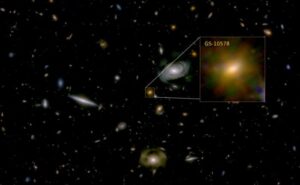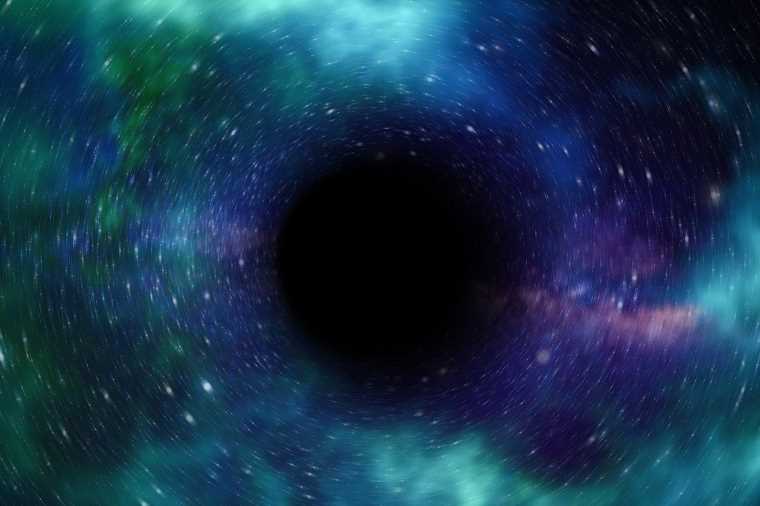NASA’s James Webb Space Telescope (JWST) has confirmed that supermassive black holes can starve their host galaxies of the fuel needed to create new stars, resulting in what astronomers call ‘dead galaxies.’
Researchers had previously theorized that supermassive black holes found at the center of galaxies might have this mortal effect on the creation of new stars. However, this research is the first to show the process at work on a distant, dead galaxy that first formed around two billion years after the Big Bang.
“Based on earlier observations, we knew this galaxy was in a quenched state: it’s not forming many stars given its size, and we expect there is a link between the black hole and the end of star formation,” explained co-lead author Dr. Francesco D’Eugenio from Cambridge’s Kavli Institute for Cosmology in a statement. “However, until Webb, we haven’t been able to study this galaxy in enough detail to confirm that link, and we haven’t known whether this quenched state is temporary or permanent.”
Dead Galaxies are Being Starved by Supermassive Black Holes
Named GS-10578 but nicknamed ‘Pablo’s Galaxy’ for the researcher who chose it for this study, the specific galaxy observed by astronomers is about the same size as the Milky Way. According to the researchers behind the discovery, its total mass is about 200 billion times the mass of our Sun.
Although exceptionally far away, its light has had billions of years to reach the JWST, offering tremendous amounts of data on itself and the supermassive black hole at its center. Also, since most of the stars in GS-10578 formed between 12.5 and 11.5 billion years ago, the lack of star formation since that early stage of galactic development led researchers to label it a dead galaxy.
“In the early universe, most galaxies are forming lots of stars, so it’s interesting to see such a massive dead galaxy at this period in time,” said co-author Professor Roberto Maiolino, also from the Kavli Institute for Cosmology.
In their published study, the researchers say they were initially intrigued by the lack of star formation over several billions of years and curious to understand why that early, robust phase of star formation within Pablo’s Galaxy seemed to come to such a rapid halt.
“If it had enough time to get to this massive size, whatever process that stopped star formation likely happened relatively quickly,” Maiolino explained.


Ultra-sensitive James Webb Space Telescope Spots Clouds of Cool Gas
To learn what caused GS-10578 to become a dead galaxy in such a short period of time, the research team utilized the unprecedented imaging power of the JWST.
As hoped, the telescope’s sensitive instruments revealed that this particular dead galaxy was expelling large amounts of gas into the vacuum of space and free of the galaxy’s gravitational pull at a surprisingly rapid 1,000 kilometers per second. Since galaxies use this massive cloud of gas to form stars, this outgassing had somehow stopped star formation in its tracks.
While previous observations of GS-10578 had spotted gas escaping into space, the researchers say the flow was primarily hot gas, which is tenuous and has very little mass. By itself, this flow of hot gas should not be enough to stop star formation.
However, the JWST’s ultra-sensitive instruments were able to spot something else. A colder and denser cloud of gas was also escaping the galaxy, effectively starving the galaxy of the fuel it needed to form new stars.
Although the JWST could not directly image this cold gas flow since it emits essentially no light, the team says they can “see” these dark gas clouds because they block some of the light from the galaxy behind them. Models show that the supermassive black hole at its center is the only thing powerful enough to push this colder gas out of the gravitational pull of the galaxy.
“We found the culprit,” said D’Eugenio. “The black hole is killing this galaxy and keeping it dormant by cutting off the source of ‘food’ the galaxy needs to form new stars.”
The study’s findings also helped to disprove a previous theory on dead galaxies that posited the cessation of star formation would have a “violent and turbulent” effect on the galaxy’s shape and order. Instead, their work found that the stars in GS-10578 were maintaining a disc shape and moving in an orderly fashion, “suggesting that this is not always the case.”
Another Way Webb is a Giant Leap Forward
Next, the research team says they hope that planned observations of dead galaxies by the Atacama Large Millimeter-Submillimiter Array (ALMA) in Chile “will tell us more about if and where any fuel for star formation is still hidden in this galaxy.” They also hope these follow-up observations can shed even more light on the effects of supermassive black holes on the regions of space surrounding their host galaxies. Until then, the researchers say their work and the unprecedented sensitivity of the JWST have helped to finally solve the mystery of why some dead galaxies exist.
We knew that black holes have a massive impact on galaxies, and perhaps it’s common that they stop star formation, but until Webb, we weren’t able to directly confirm this,” said Maiolino. “It’s yet another way that Webb is such a giant leap forward in terms of our ability to study the early universe and how it evolved.”
The study “A fast-rotator post-starburst galaxy quenched by supermassive black-hole feedback at z=3” is published in Nature Astronomy.
Christopher Plain is a Science Fiction and Fantasy novelist and Head Science Writer at The Debrief. Follow and connect with him on X, learn about his books at plainfiction.com, or email him directly at christopher@thedebrief.org.

